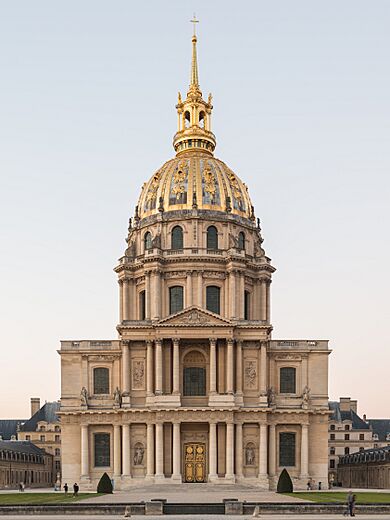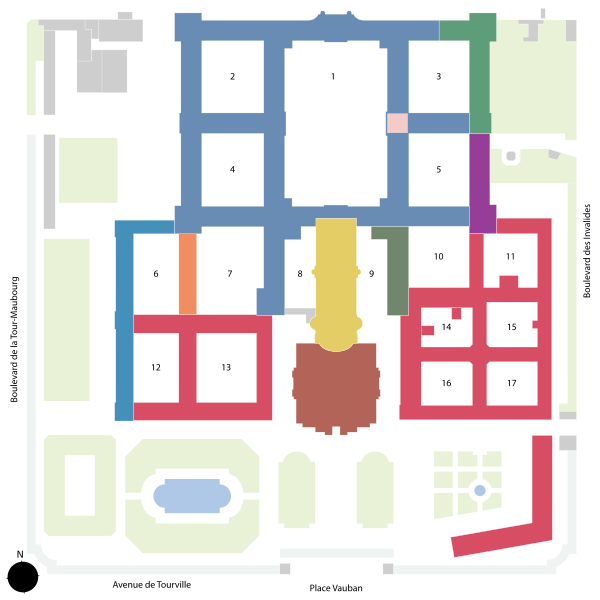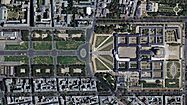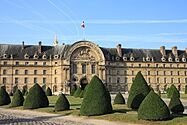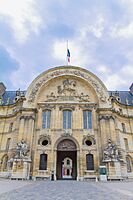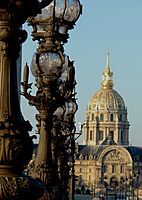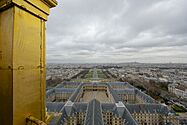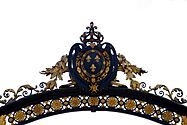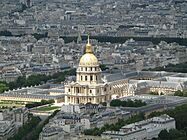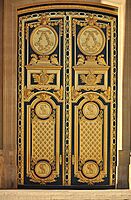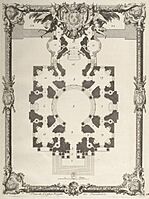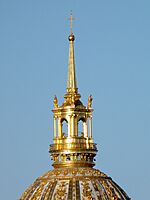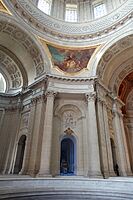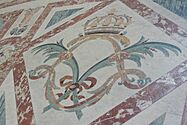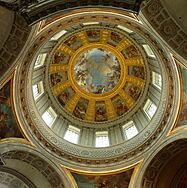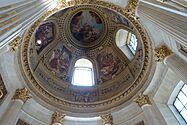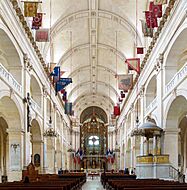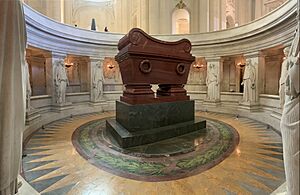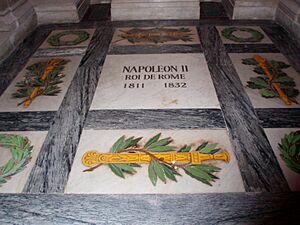Les Invalides facts for kids
Quick facts for kids Hôtel des Invalides |
|
|---|---|

Aerial view of Les Invalides
|
|
| Alternative names | Les Invalides, Musée de l'Armée |
| General information | |
| Type | Museum, church, hospital, retirement home, mausoleum |
| Architectural style | Baroque |
| Location | Paris, France |
| Coordinates | 48°51′18″N 2°18′45″E / 48.85500°N 2.31250°E |
| Construction started | 1671 |
| Completed | 1706 |
| Inaugurated | 1678 |
| Design and construction | |
| Architect | Libéral Bruant Jules Hardouin-Mansart |
The Hôtel des Invalides (which means "house of invalids" in English) is a large group of buildings in Paris, France. People often call it Les Invalides. It holds museums and monuments about France's military history. It also has a hospital and a home for retired soldiers. This was its first purpose.
Inside, you'll find the Musée de l'Armée, which is France's main military museum. There's also the Musée des Plans-Reliefs and the Musée d'Histoire Contemporaine. The complex includes a church, the Cathédrale Saint-Louis-des-Invalides. Next to it is the famous Dôme des Invalides. This dome is the tallest church building in Paris, standing 107 meters (351 feet) high. It is now a special burial place for important French military leaders, especially Napoleon Bonaparte.
Contents
History of Les Invalides
King Louis XIV ordered the building of Les Invalides on November 24, 1670. He wanted a home and hospital for soldiers who were old or had been injured. The first architect was Libéral Bruant. The chosen spot was a flat area outside the city called the plain of Grenelle.
By 1676, the building was much larger. The front facing the Seine river was 196 meters (643 feet) wide. The whole complex had fifteen courtyards. The biggest one was the cour d'honneur, used for military parades.
The church and chapel parts of Les Invalides were designed by Jules Hardouin-Mansart starting in 1676. He was inspired by his great-uncle's ideas for a royal chapel. The Dome church was meant to be a private chapel for the king. He could attend church services without mixing with the veterans.
The Dôme des Invalides is a great example of French Baroque architecture. It is 107 meters (351 feet) tall. It stands as a symbol of France's powerful monarchy. The inside of the dome was painted by Charles de La Fosse in 1705. The painting creates an amazing illusion.
Hardouin-Mansart also helped Bruant finish the veterans' chapel. This chapel is now called the church of Saint-Louis-des-Invalides. Soldiers living there had to attend daily church services. The Dome chapel was completed in 1706.
-
Jules Hardouin-Mansart’s project with unrealized south esplanade
-
Portrait of Hardouin-Mansart by Hyacinthe Rigaud showing the Dome, Louvre
-
Napoleon I visiting the infirmary of Les Invalides
Les Invalides has been part of important moments in French history. On July 14, 1789, Parisian rioters stormed it. They took cannons and muskets to use against the Bastille later that day. Napoleon was buried under the Dome of the Invalides in a grand ceremony in 1840.
In the 1800s, the two churches were separated. Napoleon's tomb was built. A glass wall was put between the two chapels.
The building kept its main job as a home and hospital for military veterans until the early 1900s. In 1872, the Artillery Museum moved in. The Historical Museum of the Armies joined it in 1896. These two museums combined in 1905 to form the Musée de l'Armée. At that time, most veterans moved to smaller centers outside Paris. The building was too big for the fewer veterans who qualified.
Today, Les Invalides still cares for about one hundred elderly or injured former soldiers. The veterans' chapel is now the main church for the Diocese of the French Armed Forces. It is officially called Cathédrale Saint-Louis-des-Invalides.
Architecture and Layout
Les Invalides is a huge and impressive building. Its design is a great example of Baroque style.
|
Dome of Les Invalides Cathédrale Saint-Louis-des-Invalides Musée de l'Armée Musée des Plans-Reliefs Musée de l'Ordre de la Libération |
Institution nationale des Invalides Gouverneur des Invalides Gouverneur militaire de Paris Chancellerie de l'Ordre de la Libération Office national des anciens combattants et victimes de guerre |
|
|
The Dome chapel is very large and stands out on the north side of Les Invalides. It fits well with Bruant's main entrance. To the north, a large public area called the Esplanade des Invalides stretches out. This is one of the grand open spaces in the center of Paris.
At the end of the esplanade, the Pont Alexandre III bridge connects to the Petit Palais and the Grand Palais. These are other famous Parisian buildings. The Pont des Invalides bridge is also nearby, further down the Seine river.
The buildings still house the National Institution of Invalides. This is a special place for disabled war veterans. It includes:
- a retirement home for veterans.
- a medical and surgical center for their care.
- a center for medical check-ups.
Gallery
-
According to an old tradition, war trophies decorate the vault of the Cathédrale Saint-Louis-des-Invalides
-
The Qianlong Emperor's military costume at the Musée de l'Armée
Famous Burials
The Dome chapel became a military burial place in 1800. Napoleon decided to move the tomb of a famous general, Henri de La Tour d'Auvergne, Viscount of Turenne, here. Later, Sébastien Le Prestre de Vauban was also buried here.
A big change happened when the building was chosen to be Napoleon's tomb. This was made official by a law on June 10, 1840. King Louis-Philippe I wanted Napoleon's remains brought back to France. This event was called retour des cendres (the return of the ashes).
Building the crypt and Napoleon's huge tomb took twenty years. It was finished in 1861. By then, Napoleon III was emperor. He oversaw the ceremony of moving Napoleon's remains into the crypt under the dome.
Inside the Église du Dôme des Invalides
The most famous tomb at Les Invalides is that of Napoleon Bonaparte (1769–1821). It was designed by Louis Visconti. Napoleon was first buried on Saint Helena island. But King Louis Philippe arranged for his body to be brought to France in 1840.
Napoleon's remains stayed in a chapel for over twenty years. His final resting place, a tomb made of red stone, was finished in 1861.
Other important military figures and members of Napoleon's family are also buried here:
- 1800: Henri de La Tour d'Auvergne, Viscount of Turenne (1611–1675), a famous general.
- 1807–1808: The heart of Sébastien Le Prestre de Vauban (1633–1707), a military engineer.
- 1847: Henri Gatien Bertrand (1773–1844), a general who was with Napoleon on Saint Helena.
- 1862: Jérôme Bonaparte (1784–1860), Napoleon's youngest brother.
- 1864: Joseph Bonaparte (1768–1844), Napoleon's elder brother.
- 1940: Napoleon II (1811–1832), Napoleon's son.
- 1937: Ferdinand Foch (1851–1929), a Marshal of France from World War I.
- 1963: Hubert Lyautey (1854–1934), a Marshal of France.
-
Tomb of Ferdinand Foch in the Dome church
Beneath the Cathédrale Saint-Louis-des-Invalides
Many other military figures are buried in an underground area called the Caveau des Gouverneurs. This is beneath the Cathédrale Saint-Louis-des-Invalides. It includes 82 military figures, such as 28 Governors of Les Invalides.
Some notable people buried here are:
- Jean-Baptiste Bessières (1768–1813), a Marshal of the Empire.
- Thomas Bugeaud (1784–1849), a Marshal of France.
- Louis Franchet d'Espèrey (1856–1942), a Marshal of France.
- Jean-Baptiste Jourdan (1762–1833), a Marshal of the Empire.
- Alphonse Juin (1888–1967), a Marshal of France.
- Philippe Leclerc de Hauteclocque (1902–1947), a Marshal of France.
- Patrice de MacMahon (1808–1893), a Marshal of France and former President of France.
- Dominique Jean Larrey (1766–1842), a famous military surgeon.
- Claude Joseph Rouget de Lisle (1760–1836), who wrote France's national anthem, La Marseillaise.
Two of these, Gabriel Malleterre and Philippe Leclerc de Hauteclocque, also have special plaques inside the Saint-Louis-des-Invalides cathedral. Another plaque honors Jean de Lattre de Tassigny (1889–1952). He was a Marshal of France and a commander in World War II.
See also
 In Spanish: Los Inválidos para niños
In Spanish: Los Inválidos para niños
- List of museums in Paris
- List of hospitals in France
- List of tallest structures in Paris
- List of tourist attractions in Paris
- List of tallest domes
- Military history of France
- San Francisco City Hall, the design of which was influenced by Les Invalides
- La Tour-Maubourg, adjacent Paris Metro stop convenient to Les Invalides
- National Pantheon of Venezuela
- Buenos Aires Metropolitan Cathedral
- National Pantheon of the Heroes
- Altar de la Patria
- Artigas Mausoleum
- List of works by James Pradier
- History of early modern period domes


